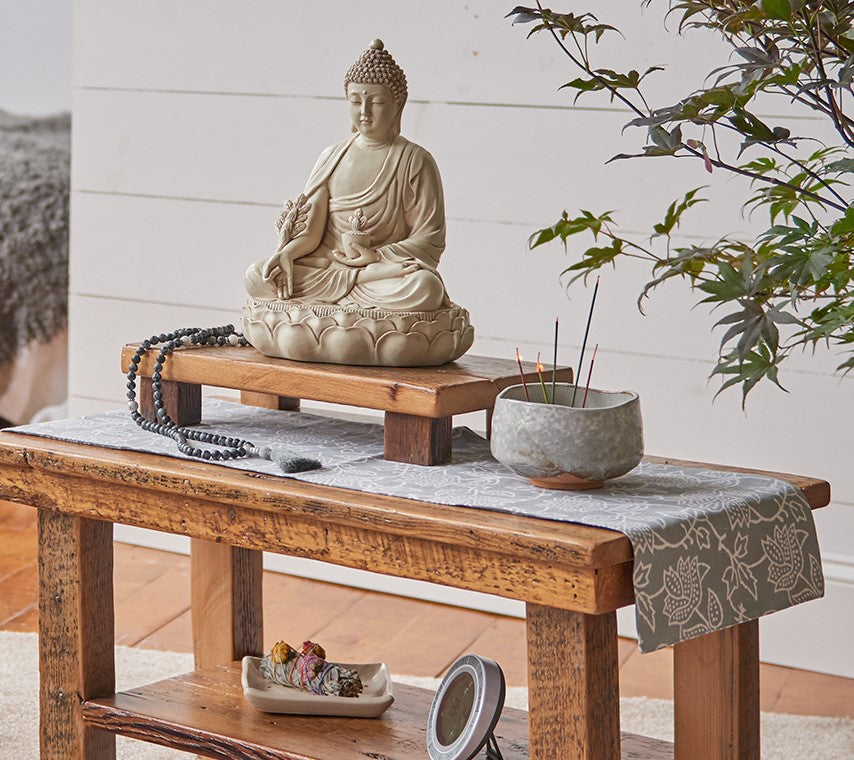Dyan in the DharmaCrafts meditation room at the former Lexington location.
DharmaCrafts founder, Dyan Eagles, has been a dedicated practitioner for years, and helped to establish the Cambridge Zen Center. She says that "Meditation is a method for looking deeply into ourself. Who am I? We can see our thoughts, our emotions, our hopes and fears. We get to know ourselves intimately, just as we are.”
“It is very helpful when establishing a meditation practice to create a special place where you sit each day. It could be a corner of a room in the house, or even just a meditation cushion. The important thing is to try to bring yourself to the same place at the same time each day." says Eagles. “We are creatures of habit, and soon you will find that you look forward to this time you spend with yourself each day, and you will feel your mind and body calm down as you take your seat in your meditation space.”
Your sacred space might include a comfortable place to sit, an altar, and a place to store your practice tools such as your meditation timer or singing bowl or incense.

Your meditation altar is a reflection of the deepest aspirations of your heart. Make it a place of beauty, refuge, and inspiration. Along with personal treasures, your shrine might hold a statue or a picture of your teacher or loved ones, and a candle.
According to Lama Willa Miller, "When you meditate, you light up the world with your aspirations, instead of dismissing the world as a shadowy place beyond your control. In Buddhist sources, a candle symbolizes sometimes the incandescence of wisdom, sometimes the guiding light of love. It also creates an ambience for peace, a pleasant glow to the room." Week three of her book Everyday Dharma focuses on the creation of a sacred space, "a place of retreat and inspiration where you can go to meditate, contemplate, and pray."
Place offerings of flowers, incense, and light on your altar to show gratitude for the blessings in your life and to express your commitment to lead a mindful, compassionate life. Sometimes in Buddhist tradition, a seven bowl set is placed on your home altar for water, candlelight, and other traditional offerings.
The Seven Traditional Offerings are: water, flowers, incense, light, perfume, food, and music. Making shrine offerings is a transformative practice for cultivating generosity and an open heart.

According to Thubten Chodron, author of How to Free Your Mind, "these offerings are based on ancient Indian culture. Whenever you had a guest into your house—and in India, remember it is very hot and dusty—first you give them something to drink, then you let them clean their dusty feet. You offer flowers because India is full of flowers, and incense and light, perfume (something to make the environment nice), then you offer them food and you have a good meal. After that, you have some entertainment or music."
In Tibetan Buddhism, the building of an altar, and making offerings can be a formal practice, as described by Thubten Chodron here.
 Home Meditation Altar Checklist:
Home Meditation Altar Checklist:
- quiet and uncluttered spot, possibly near a window with a view of nature
- table, tansu, altar, or bench
- altar cloth, or fabric that calls to you
- main sacred item such as a statue or a picture of a loved one, guru, or teacher
- a statue stand can help to keep a Buddha statue raised above the other items
- accessories, such as: candles, incense, shells or flowers in offering bowls or incense burner
- crystals, gemstones, or mala beads
Products shown: Ikat Zafu and Zabutons, Five Drawer Tansu (#F613), Buddha on Lotus Throne Bronze Finish (#ST379), Seven Bowl Offering Set (#4364), Folding Kiri Wood Table (#F040), Lotus Candleholder (#4451), White Lotus Candles (GIF157), Tibetan Brocade Plum and Gold Altar Cloth, Dark Ceramic Offering Bowl


 Dyan in the DharmaCrafts meditation room at the former Lexington location.
Dyan in the DharmaCrafts meditation room at the former Lexington location.